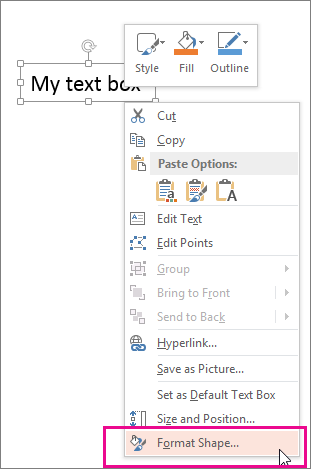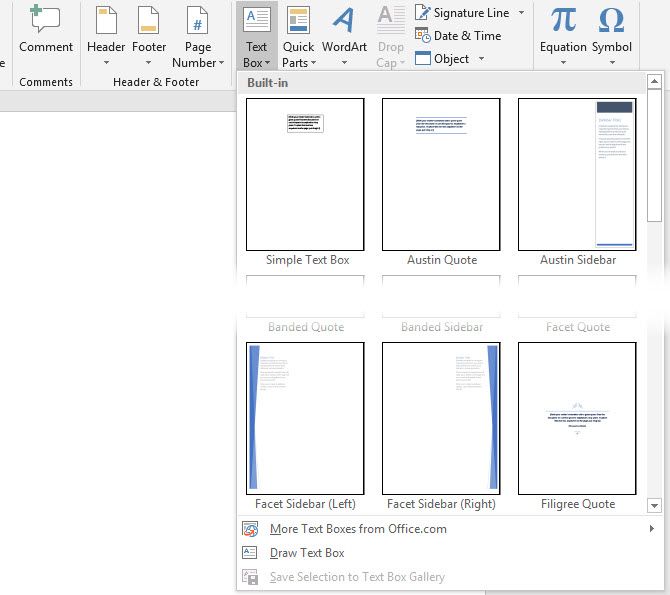After you place a text box in a Word 2007 document, you probably want to format it. You can format the text by highlighting it and using the text formatting controls on the Home tab. You can also format the text box itself by using any of the controls on the Text Box Tools Format tab, which appears whenever the text box is selected.
If you want to change the margins between the text and the text box border, select the text box and go to the Text Box Tools Format tab on the Ribbon. In the Text Box Styles group, click the small button in the lower-right corner. In the resulting Format Text Box dialog box, click the Text Box tab. Here you can set each of the margins. While you’re there, you can also change the vertical alignment of the text, and you can set the following two options:
Insert a Built-in Text Box. Switch over to the “Insert” tab on Word’s Ribbon, and then click the “Text Box” button. This opens a dropdown menu with a selection of predefined text box styles. The text box appears with a thin border and gives you 'handles' to use to resize or reposition the text box. Click on the corners or any of the handles on the sides to resize the text box. You can fine-tune the size at any time as you work in the document. The more text there is in the box, the smaller the font will be for all the text in the box, not just the first line. MS Word might now have this option but it exists in PowerPoint.
Word Wrap Text in AutoShape: You almost always want to leave this option turned on. If you turn it off and the text box isn’t wide enough, text might get cut off.
Resize AutoShape to Fit Text: This option automatically adjusts the size of the text box to fit the text you add. You usually leave this option turned off because you can always resize the text box manually by dragging any of the corner handles.
Unfortunately, you can’t freely rotate the text inside a text box. There is hope, however. Word provides a somewhat helpful Text Direction command that can rotate the text left or right 90 degrees. It doesn’t let you rotate text to any arbitrary angle, but it’s better than nothing.
To use the Text Direction command, select a text box and click the Text Box Tools Format tab on the Ribbon. The Text Direction button is near the left edge of this tab. Each time you click this button, the text rotates 90 degrees.
You can still edit text after you rotate it, but seeing letters crawl up or down the screen as you type can be disconcerting. Always remember to enter the text before you rotate the text box.
This tutorial shows how to wrap text in a cell automatically and how to insert a line break manually. You will also learn the most common reasons for Excel wrap text not working and how to fix it.
Primarily, Microsoft Excel is designed to calculate and manipulate numbers. However, you may often find yourself in situations when, in addition to numbers, large amounts of text need to be stored in spreadsheets. In case longer text does not fit neatly in a cell, you can of course proceed with the most obvious way and simply make the column wider. However, it's not really an option when you work with a large worksheet that has a lot of data to display.
A much better solution is to wrap text that exceeds a column width, and Microsoft Excel provides a couple of ways to do it. This tutorial will introduce you to the Excel wrap text feature and share a few tips to use it wisely.

What is wrap text in Excel?
When the data input in a cell is too large fit in it, one of the following two things happens:
- If columns to the right are empty, a long text string extends over the cell border into those columns.
- If an adjacent cell to the right contains any data, a text string is cut off at the cell border.
The screenshot below shows two cases:
How To Make Text Resize With Box Css
The Excel wrap text feature can help you fully display longer text in a cell without it overflowing to other cells. 'Wrapping text' means displaying the cell contents on multiple lines, rather than one long line. This will allow you to avoid the 'truncated column' effect, make the text easier to read and better fit for printing. In addition, it will help you keep the column width consistent throughout the entire worksheet.
The following screenshot shows how wrapped text looks like in Excel:
How to wrap text in Excel automatically
To force a lengthy text string to appear on multiple lines, select the cell(s) that you want to format, and turn on the Excel text wrap feature by using one of the following methods.
Method 1. Go to the Home tab > Alignment group, and click the Wrap Text button:
Method 2. Press Ctrl + 1 to open the Format Cells dialog (or right-click the selected cells and then click Format Cells…), switch to the Alignment tab, select the Wrap Text checkbox, and click OK.

Compared to the first method, this one takes a couple of extra clicks, but it may save time in case you wish to make a few changes in cell formatting at a time, wrapping text being one of those changes.
Result. Whichever method you use, the data in the selected cells wraps to fit the column width. If you change the column width, text wrapping will adjust automatically. The following screenshot shows a possible result:
How to unwrap text in Excel
As you can easily guess, the two methods described above are also used to unwrap text.
The fastest way is to select the cell(s) and click the Wrap Text button (Home tab > Alignment group) to toggle text wrapping off.
Alternatively, press the Ctrl + 1 shortcut to open the Format Cells dialog and clear the Wrap text checkbox on the Alignment tab.
How to insert a line break manually
Sometimes you may want to start a new line at a specific position rather than have lengthy text wrap automatically. To enter a line break manually, just do the following:
How To Make Text Resize With Boxes Word For Mac
- Enter cell edit mode by pressing F2 or double-clicking the cell or clicking in the formula bar.
- Put the cursor where you want to break the line, and press the Alt+Enter shortcut (e. press the Alt key and while holding it down, press the Enter key).
Result. Inserting a manual line break turns on the Wrap Text option automatically. However, the line breaks entered manually will stick in place when the column is made wider. If you turn off text wrapping, the data displays in one line in a cell, but the inserted line breaks are visible in the formula bar. The following screenshot demonstrates both scenarios (a line break in entered after the word 'owl'):
Excel wrap text not working
As one of the most often used features in Excel, Warp Text was designed as simple as possible and you will hardly have any problems using it in your worksheets. If text wrapping does not work as expected, check out the following troubleshooting tips.
1. Fixed row height
If not all wrapped text is visible in a cell, most likely the row is set to a certain height. To fix this, select the problematic cell, go to the Home tab > Cells group, and click Format > AutoFit Row Height:
Or, you can set a specific row height by clicking Row Height… and then typing the desired number in the Row height box. A fixed row height comes in especially handy to control the way the table headers are displayed.
2. Merged cells
Excel's Wrap Text does not work for merged cells, so you will have to decide which feature is more important for a particular sheet. If you keep the merged cells, you can display the full text by making the column(s) wider. If you opt for Wrap Text, then unmerge cells by clicking the Merge & Center button on the Home tab, in the Alignment group:
3. The cell is wide enough to display its value
If you try to wrap a cell(s) that is already wide enough to display its contents, nothing will happen, even if later on the column is resized and becomes too narrow to fit longer entries. To force the text to wrap, toggle the Excel Wrap Text button off and on again.

This is how you wrap text in Excel to display longer text on multiple lines. I thank you for reading and hope to see you on our blog next week!